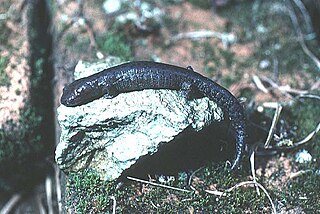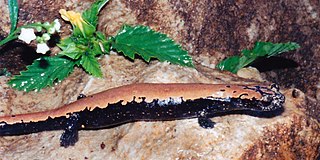The cloud forest stream frog is a species of frog in the family Hylidae found in El Salvador, Guatemala, Mexico, and possibly Honduras. Its natural habitats are subtropical or tropical moist lowland forest, subtropical or tropical moist montane forest, and rivers. The cloud forest stream frog's lower elevation limit sits at 500 meters and it's upper elevation limit is at 2,200 meters. The frog's current population trend is suspected to be decreasing due to the ongoing degradation in the quality and extent of its environment. It is common in Guatemala and Mexico, but the population status in Honduras and El Salvador are unknown. It is threatened by habitat loss. These frogs are semiaquatic, living both terrestrially and in inland freshwater.

Doflein's salamander is a species of salamander in the family Plethodontidae. It is found in Belize, Guatemala, Nicaragua and Honduras. Its natural habitats are subtropical or tropical moist lowland forests, subtropical or tropical moist montane forests, plantations, and heavily degraded former forest. An example ecoregion of occurrence is the Belizean pine forests. The species is threatened by habitat loss.
The Tapanti climbing salamander is a species of salamander in the family Plethodontidae, the salamander is endemic to Costa Rica. Its natural habitats are subtropical or tropical, moist lowland forests and subtropical or tropical, moist montane forests. Currently the species is under threat due to habitat loss.
The yellow-legged mushroomtongue salamander is a member of salamander family Plethodontidae. It is found in Guatemala and Mexico. Its natural habitat consists of subtropical or tropical moist lowland forests. It is threatened by habitat loss.
Bolitoglossa flaviventris is a species of salamander in the family Plethodontidae. It is found in Guatemala and Mexico. Its natural habitats are subtropical or tropical moist lowland forests, arable land, plantations, and heavily degraded former forest. It is threatened by habitat loss.
Franklin's climbing salamander is a species of salamander in the family Plethodontidae. It is found in Guatemala and Mexico. Its natural habitat is subtropical or tropical moist lowland forests. It is threatened by habitat loss.

The Holy-mountain salamander is a species of salamander in the family Plethodontidae. It is found in El Salvador, Guatemala, and possibly Honduras. Its natural habitat is subtropical or tropical moist montane forests. It is threatened by habitat loss.
The Coban climbing salamander is a species of salamander in the family Plethodontidae. It is endemic to Guatemala. Its natural habitats are subtropical or tropical moist montane forests and plantations . It is threatened by habitat loss.
The Guerreran climbing salamander is a species of salamander in the family Plethodontidae. It is endemic to Mexico. It is found on the Pacific slope of the Sierra Madre del Sur in the basins of the Atoyac and Tecpan rivers, between 765 and 2,800 meters elevation. Its extent of occurrence (EOO) is 1,122 km2.

The Mexican climbing salamander is a species of salamander in the family Plethodontidae. It is found in Belize, Guatemala, Honduras, Mexico, and possibly Nicaragua. Its natural habitats are subtropical or tropical dry forests, subtropical or tropical moist lowland forests, subtropical or tropical moist montane forests, plantations, and rural gardens. It is threatened by habitat loss.

Bolitoglossa mulleri is a species of salamander in the family Plethodontidae. It is found in Guatemala and Mexico. Its natural habitats are subtropical or tropical moist lowland forests, subtropical or tropical moist montane forests, plantations, and rural gardens. It is threatened by habitat loss.

The southern banana salamander is a species of salamander in the family Plethodontidae. It is found in Guatemala, Honduras, and Mexico. Its natural habitats are subtropical or tropical moist lowland forests, subtropical or tropical moist montane forests, arable land, and plantations. It is threatened by habitat loss.
O'Donnell's salamander is a species of salamander in the family Plethodontidae. It is found in Guatemala and Honduras. Its natural habitats are subtropical or tropical moist lowland forests, subtropical or tropical moist montane forests, plantations, rural gardens, and heavily degraded former forest. It is threatened by habitat loss.

Bolitoglossa peruviana is a species of salamander in the family Plethodontidae. It is found in Ecuador and Peru. Its natural habitats are subtropical or tropical moist lowland forests, plantations, and heavily degraded former forest.

Bolitoglossa platydactyla, commonly known as the broadfoot mushroomtongue salamander and broad-footed salamander, is a species of salamander in the family Plethodontidae. It is endemic to Mexico.
The robust climbing salamander is a species of salamander in the family Plethodontidae. It is found in Costa Rica and Panama. Its natural habitats are subtropical or tropical moist lowland forests and subtropical or tropical moist montane forests. It is threatened by habitat loss.
The northern banana salamander, also known as common dwarf salamander or rufescent salamander, is a species of salamander in the family Plethodontidae. It is found in the Atlantic slopes of Meso-America from San Luis Potosi, Veracruz, and northern Chiapas in Mexico continuing on to the southern part of Guatemala, Belize, and northern Honduras. However, its range south of Mexico is uncertain because the records may refer to other species.
The Cukra climbing salamander is a species of salamander in the family Plethodontidae. It is found in Costa Rica, Honduras, and Nicaragua. Its natural habitats are subtropical or tropical moist lowland forests, subtropical or tropical moist montane forests, freshwater marshes, and plantations . It is threatened by habitat loss.
Stuart's salamander is a species of salamander in the family Plethodontidae, found in Guatemala and Mexico. Its natural habitats are subtropical or tropical dry forests and subtropical or tropical moist montane forests. This salamander is threatened by habitat loss.
The Cerro Pital salamander is a species of salamander in the family Plethodontidae. It is found in El Salvador and Honduras in the Cerro El Pital. Its natural habitats are subtropical or tropical moist montane forests and heavily degraded former forest. It is threatened by habitat loss.







